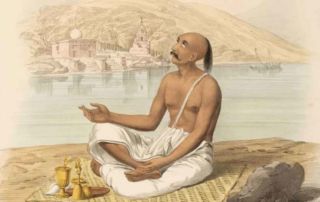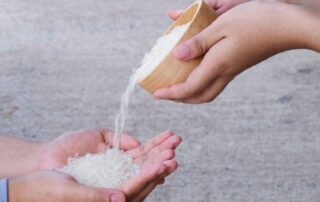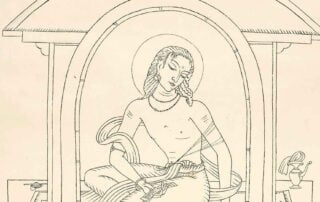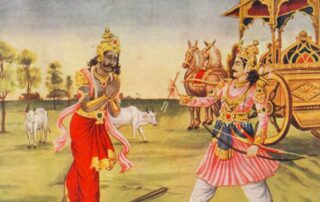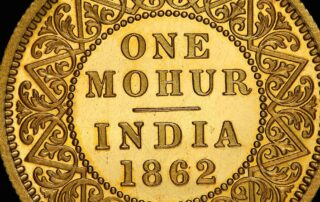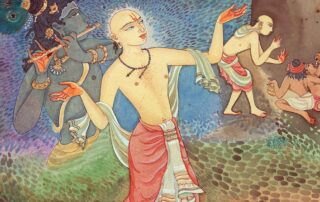Markaṭa Vairāgī (Monkey Renunciates)
Markaṭa Vairāgī (‘Monkey Renunciates’) was first published in Sajjana Toṣaṇī, Vol.8, Issue 10 in 1897. In this article, Śrīla Bhaktivinoda Ṭhākura discusses Mahāprabhu’s instructions to Raghunātha Dāsa Gosvāmī as well as the two types of fake renunciates found in both the gṛhastha āśrama and the sannyāsa āśrama.
Śrī Vaiṣṇavera Varṇāśrama (‘The Varṇāśrama of a Pure Vaiṣṇava’)
Śrī Vaiṣṇavera Varṇāśrama ('The Varṇāśrama of a Pure Vaiṣṉava') was first published in Sajjana Toṣaṇī, Vol. 11. Issue 10 in 1900. In this article, Bhaktivinoda Ṭhākura explains how pure Vaiṣṇavas are transcendental to varṇa and āśrama because all of their activities are meant for cultivating kṛṣṇa-bhakti.
Bhek Dhāraṇa (Accepting the Dress of a Bābājī)
Bhek Dhāraṇa (Accepting the Dress of a Bābājī) was first published in Sajjana Toṣaṇī Vol. 2 issue 7 in 1885. In this article, Bhaktivinoda Ṭhākura discusses bhek-dhāraṇa (the acceptance of the bābājī āśrama) and how those who have polluted it are ‘a black spot on Vaiṣṇava dharma.’
A Vaiṣṇava Householder’s Hospitality to Guests (Vaiṣṇava Gṛhasthera Ātithya)
'Vaiṣṇava Gṛhasthera Ātithya (A Vaiṣṇava Householder's Hospitality to Guests)' was first published in Sajjana Toṣaṇī Vol.8. issue 12 in 1897. Bhaktivinoda Thākura writes about serving guests, the foremost duty of a householder, and compares Vaiṣṇava guests with common guests.
The Livelihood of Householder Vaiṣṇavas (Gṛhastha Vaiṣṇava-digera Jīvanavṛtti)
‘Gṛhastha Vaiṣṇava-digera Jīvanavṛtti (The Livelihood of Householder Vaiṣṇavas)' was first published in Sajjana Toṣaṇi, Vo.7, issues 1 and 2 in 1895. Herein Bhaktivinoda Ṭhākura discusses the proper occupational duties of householders, and especially those who are in government service. He also speaks against bribery and corruption in high office according to the teachings of Mahāprabhu.
The Brāhmaṇa and the Vaiṣṇava – Both are Completely Vedic (Brāhmaṇa u Vaiṣṇava – Ubhaye-i Sampūrṇa Vaidika)
Brāhmaṇa u Vaiṣṇava – Ubhaye-i Sampūrṇa Vaidika (The Brāhmaṇa and the Vaiṣṇava – Both are Completely Vedic) was first published in Sajjana Toṣaṇi, Vo.1 in 1881. This article by Bhaktivinoda Ṭhākura portrays some of the differences between Brahmanism and Vaiṣṇavism, and why they are ultimately discordant.
Sādhu Śikṣā (Holy Teachings)
'Sādhu Śikṣā (Holy Teachings)' was first published in Sajjana Toṣaṇi, Vo.5. issues 10,11 and 12, in 1893. In this article, Bhaktivinoda Ṭhākura talks about the two ways a sādhu teaches, and explains how the conduct of a Vaiṣṇava is most important. At the end of the article, he gives a selection of ślokas from Śrī Caitanya-caritāmṛta and Śrī Caitanya-bhāgavata that clarify his point.
Kali
'Kali' was first published in Sajjana Toṣaṇī, Vol. 15, issue 1 in 1903. In this article Bhaktivinoda Ṭhākura gives a detailed explanation of the four major vices of Kali-yuga and why they are impediments to pure bhakti.
Vaiṣṇavera Sañcaya (The Savings of a Vaiṣṇava)
'Vaiṣṇavera Sañcaya (The Savings of a Vaiṣṇava) was written by Bhaktivinoda Ṭhākura for Sajjana Toṣaṇī, Vol.5, issue 11 in 1894. Śrīla Bhaktivinoda Ṭhākura describes in this article how it is not wrong for householder Vaiṣṇavas to save money in order to maintain their families and to engage in kṛṣṇa-sevā and vaiṣṇava-sevā. He also describes the rules for householders and mendicants.
Paramārthī Ke? (Who is a Paramārthī?)
Paramārthī Ke? (Who is a Paramārthī?) was published by Śrīla Bhaktivinoda Ṭhākura in Sajjana Toṣaṇī, Vol.4, issue 1 in 1892. Bhaktivinoda Ṭhākura explains the meaning of the word 'paramārtha' and differentiates between artha (a mundane objective) and paramārtha (the highest objective).


